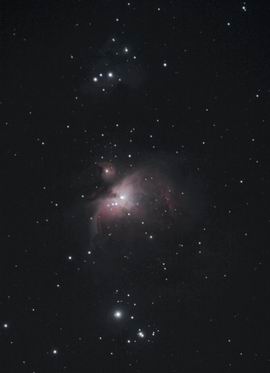The “Great Orion Nebula”, also called Messier 42, is one of the finest night-sky objects. About 23 years ago I observed it for the first time – and even today this object amazes me. One can enjoy this object by naked eye, with binoculars or with a large telescope. It is a spectacular sight independent from the instrument which one choses for observing.
Last friday I had a few moments with this object just before the Sky was covered by a thick layer of fog. Here is a photo:
I used a Canon 350D DSLR attached to a 500mm f/5.6 lens mounted on a Vixen GP-D2. The GP-D2 was controlled by a Littlefoot control box. The camera was set to 800 ASA sensitivity and RAW-format. The overall exposure time was 15 minutes, several frames were stacked with DeepSkyStacker. Of course, there is a lot of room for improvements. Nevertheless, this shot shows the features one would see in a visual observation with a small telescope.
What is this object? It is a giant cloud of gas in the space which is excited by the light on of the stars in it. The molecules of the gas emitt the light that we can observe. As far as we learned from studies and observations, the cloud contains young stars. It is a “starbirth” region.
See you later, Frank


How young are the stars in the cloud? And, how old will they get before they die?
Hi LB! It’s difficult to say. Probably a few dozen million years. The death of a star depends on its mass. Big stars die after a few million years. Stars like our sun live for more than 10 billion years.
Pingback: Diax's Rake
Pingback: Asterythms - der Blog » Orionnebel M42, Teil 2